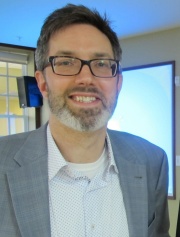David Pringle

I am very fortunate to have had this experience with diverse methods in Dalhousie’s economics program, something that was noticeably lacking in my later graduate studies
My name is David Pringle and I graduated BA (Honours Economics and IDS) in 1996 from Dalhousie. Currently I am a senior economist at the federal Department of Finance, the chair of the Progressive Economics Forum and I teach labour economics at Carleton University.
In the wake of the 2008 Great Recession, Nobel laureate Paul Krugman wrote that much of the macroeconomics of the past thirty years was “spectacularly useless at best, and positively harmful at worst”. I was intrigued by his assertion, for it was during these thirty years I was taught macroeconomics. In fact, I’ve wondered about Krugman’s assertion ever since my final undergrad year at Dalhousie in 1995-1996 when I took advanced macroeconomic theory by the late John Cornwall and advanced microeconomic theory by the late Erwin Klein. The two distinct views on economic method conveyed in these courses left me more puzzled than assured.
John Cornwall’s macroeconomics was not organized around explaining the latest formal macro models about short-run fluctuations, be they New Classical, Real Business Cycle or New Keynesian, models I would later study in grad school. Instead, he taught us about the fate of Western economies faced with slowing long-term economic and employment growth, a development of the stagflationary 1970s. John did this by presenting us with a system of empirically-grounded models. While his system did not have the elegant parsimony of the rival Solow growth model, it did hang together in such a way as to be persuasive, especially in explaining the divergent growth histories of Britain and Japan in the post-war period. John was also careful to recognize institutions and policy in explaining variations in performance across economies. While he never identified himself as such, I would later discover John’s affiliation with Post-Keynesian economics.
Come January, with Cornwall’s macro still fresh in my mind, I began Erwin Klein’s microeconomics. This involved a radical shift in method. Using set theory and topology, Erwin guided us through the meticulous logical construction of an abstract economy, the famous Arrow-Debreu model of competitive equilibrium. The approach was axiomatic and ahistorical, an exercise of pure thought with little reference to empirical facts. The kinked demand curves and consumer attribute theory of intermediate micro were conspicuously absent. Erwin’s micro was rooted in the mathematical economics movement inspired by 19th French economist Léon Walras. What the approach lacked in realism, it made up for in precision.
While Erwin did not elaborate much on the intentions of this Walrsian research program, I would later learn that the Arrow-Debreu model would serve as the microfoundations in several new macro models. Ironically, these models, such as the Real Business Cycle variety, were created in response to the shortcomings of conventional Keynesian models to explain the stagflationary 1970s, with one of the charges being that these older models lacked sufficient microfoundations. For it is these new macro models that Krugman criticized in 2009! However, these are not the models that Cornwall taught, which display a wholly different approach to construction.
Since the financial crisis, there is evidence that the discipline has started to rethink its approach to both micro and macro. For example, the view that there are no other alternative micro foundations for macroeconomics has been undermined by developments in the new field of behavioral economics, which have overturned fundamental assumptions about human behavior.
Back to Dalhousie, one of my regrets is that I never engaged these two professors on their different approaches to economic method. Sadly, I can not now, leaving spectres of solitude to haunt the third floors of Maxwell House. However, the addition of a methods course to the undergraduate curriculum, similar to what is found in other departments, would go a long way to provide students with a formal guide to better understand why economists do the things they do, like comparing the long-term post-war growth rates of European economies or demonstrating that a competitive equilibrium is Pareto optimal. That said, I am very fortunate to have had this experience with diverse methods in Dalhousie’s economics program, something that was noticeably lacking in my later graduate studies. The encounter with Cornwall and Klein has shaped my thinking ever since.
